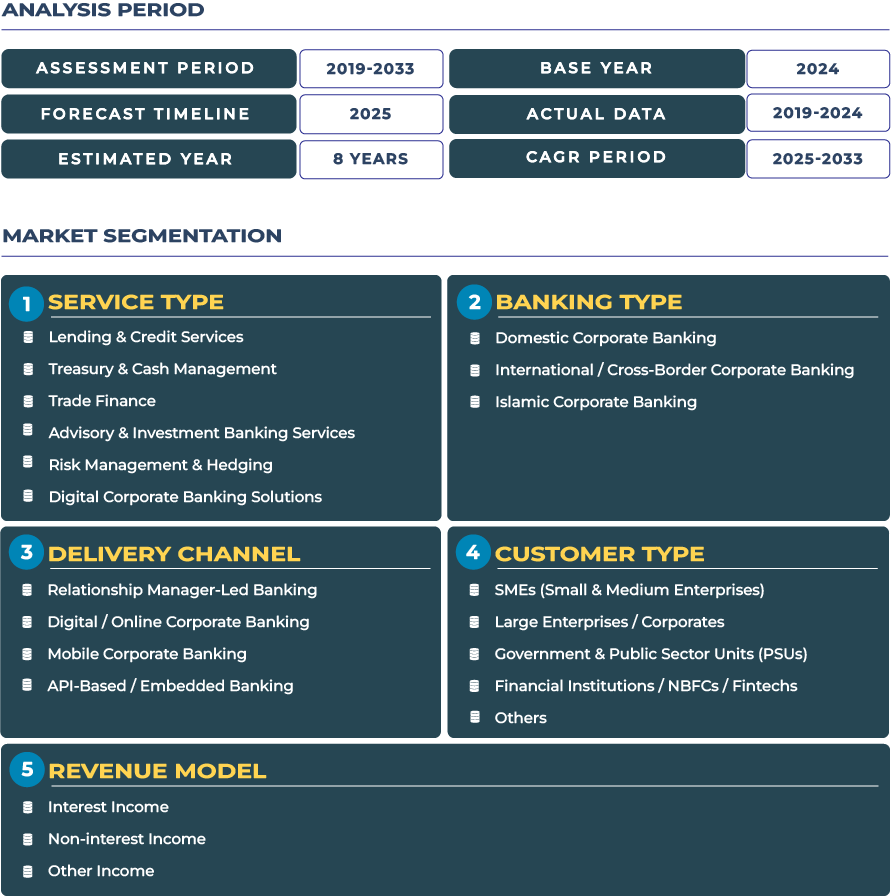Sustainability-Focused Corporate Banking in Canada: ESG Lending and Green Bonds for Enterprises
Canadian corporate banks are increasingly embedding sustainability into their product suites, transforming the corporate banking sector to support green growth and climate-aligned investment. Leading institutions now offer ESG-linked loans, green bond underwriting, and sustainability advisory services to support industries transitioning to low-carbon operations. This evolution is not merely decorative: the Canada corporate banking market is forecast at USD 67.6 billion in 2025, scaling to USD 76.0 billion by 2033 at a CAGR of 1.5% per DataCube Research. The modest growth rate reflects Canada’s mature banking ecosystem and concentrated market structure, but the push toward green finance provides a differentiation lever. In this environment, banks that deliver structured sustainability products, whether financing clean-tech development or structuring transition-linked bond frameworks, can capture premium margins and deepen corporate client relationships.
Note:* The market size refers to the total revenue generated by banks through interest income, non-interest income, and other ancillary sources.
Canada Corporate Banking Market Outlook: Green Finance and Prudential Innovation Powering Canadian Corporate Banking
Canada corporate banking landscape is at a turning point: innovation in sustainability, regulatory encouragement, and digital modernization converge to reshape the sector. The Office of the Superintendent of Financial Institutions (OSFI) has signalled openness to “smart risk” expansion to support further lending growth, nudging large banks to be more dynamic in capital allocation. Meanwhile, the Canadian government’s issuance of its fifth green bond reinforces commitment to sustainable financing structural development. Canadian banks increasingly align their strategies to decarbonization goals, even as political pressures and regulatory changes reshape disclosures. Recent departures of several Canadian banks from the Net-Zero Banking Alliance reflect tensions between climate ambition and regulatory constraints. Nonetheless, demand from corporates for green infrastructure, renewable energy, and ESG-linked lending offers growth pathways even in a low-growth macro environment. The corporate banking ecosystem in Canada must thus balance defensive capital discipline with strategic investment in sustainable offerings to remain competitive and relevant.
Drivers & Restraints: Environmental Imperatives and Systemic Barriers in Canadian Corporate Banking
Drivers: Commodity Export Finance, FX Hedging Demand & Sustainability Mandates
Canada corporate banking growth is undergirded by strong demand from resource exporters, industrial conglomerates, and firms seeking international expansion. Commodity-linked sectors rely on structured trade finance and hedging solutions to manage FX and price volatility. Corporate clients with global exposure increasingly enlist banks for tailored foreign exchange strategies and working capital optimization. Parallelly, sustainability mandates from boards and investors push banks to provide ESG-aligned finance, green loans, sustainability-linked bonds, and transition capital. Financial institutions such as RBC are expanding their sustainable finance capabilities, and CIBC offers structured sustainable finance solutions across sectors, reinforcing ESG as a growth axis for corporate banking.
Restraints: Scale Limits, Risk Aversion & Sector Concentration Constraints
However, growth in the Canadian corporate banking sector is constrained by structural features and risk tolerances. Regional banks often lack the scale to compete across North America, limiting their ability to deliver large syndicated deals. The dominant Big Six banks exert market power, compressing margins for mid-tier challengers. Conservative post-stress test credit appetites hamper aggressive lending, especially to complex renewables or transition sectors. Geographic concentration in resource-rich regions exposes banks to sectoral downturns. Moreover, recent exits from global climate alliances reflect heightened regulatory scrutiny: RBC withdrew its sustainable finance targets in response to amendments in Canada’s Competition Act, complicating disclosure and ambition for ESG-linked products.
Trends & Opportunities: Digital ESG Financing and Indigenous Co-investment as Differentiators
Trend: Green Infrastructure Co-financing and Digital KYC Acceleration
A major trend in the Canada corporate banking ecosystem is the rise of green infrastructure co-financing, especially with Indigenous community partnerships in energy, mining, and utilities. Banks are structuring financing for regional renewable projects, leveraging government incentives and co-investment frameworks. Concurrently, corporate onboarding is evolving: banks are adopting digital KYC and remote verification to streamline client acquisition, reduce friction, and expand SME reach across provinces. Mid-market and cross-provincial firms now expect seamless digital treasury onboarding akin to global banks. Further, consolidation among regional banks enables scale efficiencies and platform harmonization across Canada.
Opportunity: Commodity-Specialist Desks, Indigenous Co-Funding, and U.S.-Canada Cash Pooling
Several structural opportunities present to Canadian corporate banks. Establishing specialist commodity-finance desks enables more precise risk pricing and capital deployment in sectors like oil, gas, and mining. Partnering with Indigenous communities for renewable projects unlocks capital in resource-rich provinces while fulfilling ESG and reconciliation objectives. There is also scope to build cross-border cash pooling solutions with U.S. counterparts, multinationals with Canadian operations often require integrated treasury services. Banks that provide seamless U.S.-Canada liquidity management can enhance competitiveness for corporate clients operating across the border.
Competitive Landscape: Sustainable Strategy, Sector Differentiation & Strategic Alliances
Canadian corporate banks differentiate through sustainability strategies, sector-focused desks, and digital innovation partnerships. Royal Bank of Canada had to retract its public sustainable finance goals after regulatory changes, highlighting the tension between ambition and compliance. Several banks, including BMO, have exited the Net-Zero Banking Alliance, signaling recalibration of climate commitments. Still, RBC and others continue sustainable finance issuance under internal metrics. On the innovation front, TD launched a tech-focused banking unit, TD Innovations Partners, to serve high-growth companies, enhancing its corporate banking footprint. CIBC offers structured sustainable finance capabilities, while Scotiabank promotes sustainable trade and transition frameworks in corporate banking. Beyond that, Equitable Bank’s issuance of a €500 million social covered bond illustrates how smaller players can break into sustainability capital markets. Banks are also forming alliances with fintechs to digitize corporate lending, KYC, and capex management. Successful strategies will combine differentiated sector expertise, capital-aligned ESG offerings, and agile digital platforms to advance in Canadian corporate banking.







